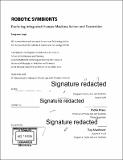Robotic symbionts : exploring integrated human-machine action and expression
Author(s)
Leigh, Sang-won
DownloadFull printable version (22.56Mb)
Alternative title
Exploring integrated human-machine action and expression
Other Contributors
Program in Media Arts and Sciences (Massachusetts Institute of Technology)
Advisor
Pattie Maes.
Terms of use
Metadata
Show full item recordAbstract
Throughout history we have augmented our physical abilities with machines. Concepts for flying machines and the ideas behind today's exoskeletons were recorded as early as the 13th century. Today, as technology permeates every aspect of our lives, it is easy to imagine a much closer integration of machines into the tasks we carry out. This thesis explores a vision of humans and machines symbiotically working together on a task through co-action and coagency. This vision opens up many opportunities in between the extremes of autonomous robots and master-slave systems, through more complex systems in which human and machine collaborate to perform actions and manipulate robotic extensions. This dissertation also reports on three extensive experiments, each consisting of multiple iterations of actual, tested designs: a series of robotic extra-numerary finger robots for increasing manual dexterity, a series of collaborative human-drone drawing systems enabling novel expressive capability, and a series of semi-automated guitar systems enabling extended musical expression as well as new instrument-learning opportunities. The studies performed with these prototypes give insight into the impact of such robotic integration on the human user: the user is nudged to adapt to the new condition and re-calibrate the expectations associated with certain input actions; the division of roles allows the user to explore and understand experiences outside their given skills or physical limits; and the robotic extension inspires activity outside of the user's regular practice. Finally, the thesis also defines a design space and corresponding terminology to situate different technical and design choices for these new forms of human-robot integration. I categorize some of the existing approaches based on how human and robotic actions are coordinated, and how the robotic movements are controlled. I also propose ways to qualitatively describe the interaction between human and machine, in terms of how the robotic extension may affect the cognition and behaviors of its user. The experiments with the prototypes support and are analyzed through these definitions, and discuss how we could achieve novel or synergistic outcomes with robotic augmentations.
Description
Thesis: Ph. D., Massachusetts Institute of Technology, School of Architecture and Planning, Program in Media Arts and Sciences, 2018. Cataloged from PDF version of thesis. Page 170 blank. Includes bibliographical references (pages 157-169).
Date issued
2018Department
Program in Media Arts and Sciences (Massachusetts Institute of Technology)Publisher
Massachusetts Institute of Technology
Keywords
Program in Media Arts and Sciences ()